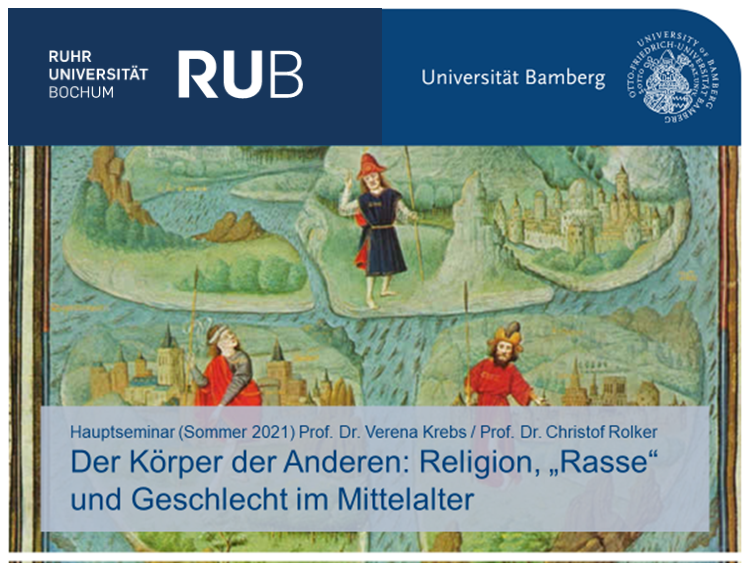
Welche Rolle spielten körperliche Differenzen in mittelalterlichen Gesellschaften, wenn es um die Unterscheidung von Menschen nach Ethnie, Religion, Geschlecht und Temperament ging? Welche kulturelle Bedeutung hatten Hautfarbe, Körpergröße, „Säfte“ (wie Blut und Galle), Haare, körperliche und geistige Fähigkeiten, wenn es in gelehrten Diskursen um die Unterschiede zwischen verschiedenen Menschen ging? Welche Eigenschaften unterschieden überhaupt den Mensch vom Tier? Im Seminar/In der Übung werden wir einschlägige medizinische, ethnographische, theologische und andere Quellen lesen und diskutieren. Eine Kenntnis von Quellensprachen (v.a. Latein) ist nicht erforderlich; alle Texte werden in englischer oder teilweise in deutscher Übersetzung zur Verfügung gestellt.
Die Veranstaltung findet ausschließlich online (Zoom on premise) in Kooperation mit Prof. Dr. Christof Rolker (Universität Bamberg) statt.
Caroline Walker Bynum, Material Continuity, Personal Survival, and the Resurrection of the Body. A Scholastic Discussion in Its Medieval and Modern Contexts, in: History of Religions 30 (1990), 51–85. http://www.jstor.org/stable/1062792
Steven A. Epstein, Purity Lost: Transgressing Boundaries in the Eastern Mediterranean, 1000–1400, Baltimore 2007. https://ebookcentral.proquest.com/lib/ub-bamberg/detail.action?docID=3318375
Shelly Errington, Recasting sex, gender, and power. A theoretical and regional overview, in: Power and difference. Gender in island Southeast Asia, hg. von Jane M. Atkinson und Shelly Errington, Stanford 1990, 1–58. http://books.google.de/books?hl=de&lr=&id=FgWrAAAAIAAJ&oi=fnd&pg=PR15&dq=Recasting+sex,+gender,+and+power&ots=9f5c5OCH3x&sig=Hrcnf3Pc8-Ea8qTyUzADAZ9t-j8#v=onepage&q&f=false
Monica Helen Green, The Diversity of Human Kind, in: A Cultural History of the Human Body in the Medieval Age, hg. von Linda Kalof (A Cultural History of the Human Body 2), Oxford und New York 2010, 173–190. https://www.academia.edu/6290062/Monica_H._Green_The_Diversity_of_Human_Kind_in_A_Cultural_History_of_the_Human_Body_in_the_Middle_Ages_Oxford_Berg_2010_pp._173-90
David M. Goldenberg, The Curse of Ham: Race and Slavery in Early Judaism, Christianity, and Islam (Jews, Christians, and Muslims from the Ancient to the Modern World 33), Princeton 2003. https://ebookcentral.proquest.com/lib/ub-bamberg/detail.action?docID=475861
Valentin Groebner, Complexio/Complexion: Categorizing Individual Natures, 1250–1600, in: The Moral Authority of Nature, hg. von Lorraine Daston und Fernando Vidal, Chicago und London 2004, 361–383. http://books.google.de/books?id=xxwMMeEFG8sC&lpg=PP1&dq=isbn%3A0226136809&hl=de&pg=PA361#v=onepage&q&f=false
———, Mit dem Feind schlafen. Nachdenken über Hautfarben, Sex und "Rasse" im spätmittelalterlichen Europa, in: Historische Anthropologie 15 (2007), 327–338.
Marina Münkler und Werner Röcke, Der ordo-Gedanke und die Hermeneutik der Fremde im Mittelalter. Die Auseinandersetzung mit den monströsen Völkern des Erdrandes in: Die Herausforderung durch das Fremde, hg. von Jürgen Trabant, Berlin 1998, 701–766.
Katharine Park, Medicine and Natural Philosophy, in: The Oxford handbook of women and gender in medieval Europe, hg. von Judith M. Bennett und Ruth Mazo Karras, Oxford 2013, 84–102. http://books.google.de/books?id=QThLAAAAQBAJ
Debra Higgs Strickland, Saracens, Demons, and Jews: Making Monsters in Medieval Art, Princeton 2003. http://books.google.de/books?id=pkcnIXxClUUC
- Kursleiter/in: Verena Krebs
- Kursleiter/in: Jona Mahatma Ratering
- Kursleiter/in: Christof Rolker
- Kursleiter/in: Heike von Hagen
